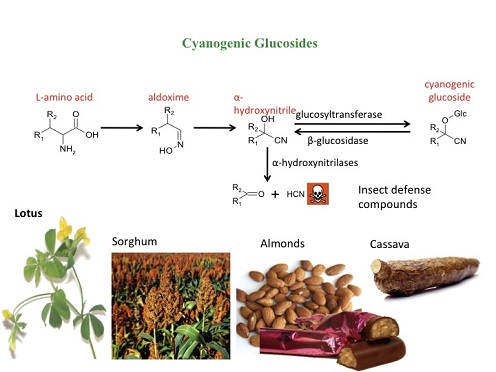Plant Biochemistry Research
A main research interest of mine within plant biochemistry is bio-active natural products. The focus of my research group is the biosynthesis, transport, storage and degradation of cyanogenic glucosides and elucidation of their role in the ability of plants to communicate with the environment and to defend themselves against attack from herbivores, pests and abiotic stress.
Plants have used the release of toxic hydrogen cyanide gas to deter generalist herbivores and pests since early in terrestrial plant evolution. The compounds giving rise to hydrogen cyanide release are typically cyanogenic glucosides. Our lab has pioneered the elucidation of cyanogenic glucoside biosynthesis and catabolism in plants. Cyanogenic glucosides are formed from amino acids and the biosynthetic pathway involves two multifunctional cytochrome P450 enzymes and a soluble UDPG-glucosyltransferase. Studying these two enzyme classes are therefore central to understanding the roles of cyanogenic glucosides in plants. Catabolism of cyanogenic glucosides is initiated enzymatic hydrolysis by a β-glucosidase to provide the corresponding unstable α-hydroxynitrile and results in a rapid release of toxic hydrogen cyanide (HCN).
Cytochrome P450 enzymes are found in all kingdoms. They are monooxygenases catalyzing regio- and stereospecific hydroxylation of a range of complex organic molecules. In plants they constitute one of the largest enzyme families with 273 members in the simple model plant Arabidopsis and many more in most crop plants. Two thirds of the P450s in plants are involved in synthesis of bio-active molecules that enable the plant to defend itself towards insect and fungal attack, to adapt to other environmental challenges and to communicate with the environment.
Figure 1: : Cyanogenic glucosides are secondary metabolites found in a number of plant species. They are derived from amino acids and formed through a number of steps involving the formation of an aldoxime and an α-hydroxynitrile. The α-hydroxynitrile is then glucosylated to form the cyanogenic glucosides. The cyanogenic glucosides can be degraded by the use of beta-glucosidases to from the aglycone, which is labile and therefore either spontaneously or through α-hydroxynitrilases forms an aldehyde with the release of cyanide.In intact tissues, cyanogenic glucosides are stored in the vacuole inside the cells, and the β-glucosidase in the cell wall or apoplast. Disruption of the cellular structure by chewing insects or by pests brings the cyanogenic glucosides and β-glucosidase into contact resulting in rapid hydrolysis and HCN release. Thus the β-glucosidases serve to detonate a “cyanide bomb” offering an immediate defence response
Many different classes of plant defense compounds are known. Cyanogenic glucosides are one such class of compounds present in ferns, gymnosperms and angiosperms. Upon cell disruption, these compounds are hydrolyzed to release toxic hydrogen cyanide gas to provide an immediate defense response. My research group has pioneered the identification and characterization of the cytochrome P450s involved in cyanogenic glucoside formation and shown that this pathway is organized within a metabolon.
Most fungi turn out to be resistant to hydrogen cyanide. I aim to investigate whether the cyanogenic glucoside metabolon disassembles during fungal attack to instead produce toxic oximes at the site of fungal infection. This would represent a currently undiscovered defense system in plants. Such defense systems may also operate in plants producing other classes of phytoanticipins like the glucosinolates.
My research group also investigates plant-insect interactions especially co- and counter evolution and adaptation between plants and insects with special focus on herbivorous insects able to use plant defence systems to their own benefit. Such knowledge is important to developing robust insect and disease resistant crops for the future to meet a steadily increasing demand for food.
In studying the above mentioned topics, I want my research group to master the combination of strong basic biological knowledge, systems biology approaches and to efficiently integrate the new powerful tools of metabolomics, transcriptomics and proteomics in the research.
Other research interests of mine include metabolon formation, self-assembly in biological systems, and molecular modeling. These interests tap into my cross-disciplinary research activities within synthetic biology. Read more here: https://synbio.ku.dk/research-presentation/
